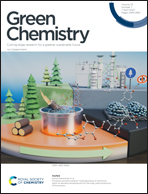Unlocking the photo-dehydrogenation ability of naphthalene monoimide towards the synthesis of quinazolinones†
Abstract
Naphthalene monoimide (NMI) molecules have recently been discovered to act as a powerful reductant to trigger strong C–Cl bond cleavage reactions. In this report, we explore its efficiency in dehydrogenation reactions under photochemical conditions. Upon photoexcitation, the molecule can be easily reduced by KOtBu, and the monoreduced form is a potent hydrogen atom abstractor to lead to efficient dehydrogenation processes. Exploiting its dehydrogenating ability, we assemble the heterocyclic molecule quinazolinone starting from o-aminoaryl nitriles and alcohols under aerobic atmosphere. This sustainable, room-temperature protocol affords a broad substrate scope and rivals numerous transition metal-catalyzed methods, which often require high temperatures. Intermediate isolation, Stern–Volmer experiment, and X-band EPR spectroscopic signature for crucial radical intermediate leave valuable clues for the mechanistic course of the reaction and altogether demonstrate the NMI molecule's great potential in steering the dehydrogenating ability under photochemical conditions.



 Please wait while we load your content...
Please wait while we load your content...